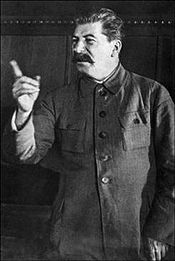Stalinism
 From Conservapedia
From Conservapedia Stalinism is the most common form of Communist ideology and is associated with the Soviet leader Joseph Stalin. It is generally declared a form of Marxism-Leninism, but some historians consider it an extreme deviation. It is generally used to describe typical Communist states which engage in heavy repression of dissent and governance by an autocratic dictator, such as the Soviet Union during Stalin's leadership, Albania under the late Enver Hoxha, and today, North Korea. More generally it refers to the ideology following the succession of Marx > Engels > Lenin > Stalin, which was the official ideology of the entire Soviet Bloc as well as the Communist Party USA during the Cold War and remains so today. Stalinism is distinguished from forms of Communist ideology which draw from Marx, Engels, and (usually) Lenin but not from Stalin, such as Trotskyism. Trotskyists are generally anti-Stalinists. Maoism and Juche are both forms of Stalinism which add on top of Stalin's ideology the additional teachings of Mao Zedong and Kim Il Sung respectively. Stalinism has been dubbed "red fascism" by The New York Times.
Stalinism revolves around a centralized state, a high degree of totalitarianism, usage of a secret police and propaganda, and autocracy. Some communist apologists declare Stalinism a caricature of communism and consider it to deviate far from its original intent. Stalinism is really more of a form of big government and bureaucracy rather than an ideology, making the next stage of Marixism-Leninism. It is an interpretation of the ideas of Marx and Lenin, for a transition from socialism to communism. However, some communist apologists who hold Marxist-Leninist beliefs consider Stalinism to be a perversion of their beliefs.
Front organizations[edit]
Stalin explained how community organizers function to further communism:
| “ | We have fashioned a number of organization without which we could not wage war on capitalism: trade unions, cooperatives, workshop committees, labor parties, women's associations, a labor press, educational leagues, youth societies.
A often as not these are non-party organizations and only a certain proportion of them are linked with the party. But under special conditions, every one of these organizations is necessary; for, lacking them, it is impossible to consolidate the class positions of the workers in the various spheres of the struggle. There is a veritable ant heap of independent organizations, commissions, and committees comprising millions of non-party members. Who decides upon the direction that all these organizations take? Where is the central unit of organization that wields sufficient authority to keep them within prescribed lines in order to achieve unity of command and to avoid confusion? The central unit is the Communist party! [1] |
” |
See also[edit]
References[edit]
Categories: [Communism] [Anti-American]
↧ Download as ZWI file | Last modified: 02/15/2023 04:01:06 | 14 views
☰ Source: https://www.conservapedia.com/Stalinism | License: CC BY-SA 3.0
 ZWI signed:
ZWI signed:

 KSF
KSF